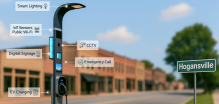With more than 50,000 connected light points stretching across 1.2km along the city’s iconic waterfront, the “lighting facelift” is the largest ever implementation Signify has undertaken. Committed to helping Chinese cities develop more eco-friendly business and tourist landmarks, the LED connected lighting will lower energy use and reduce operating costs. China’s second largest city by population is set to save 50-70% of its lighting cost per annum in comparison to its previous conventional lighting.
"The upgraded lighting system helps demonstrate Shanghai’s cultural heritage in a more vivid way, creating impressive night scenes in an energy efficient way,” said John Wang, president of Greater China, SVP, Signify.
Each Phillips luminoire can be remotely monitored via the Signify Interact Landmark, which controls the lighting across the building rooftops and its bridges. These can then be controlled individually or in groups to create dynamic night scenes across the year.
A late-night mode can be switched on to facilitate energy saving and further extend the life of the lights, whilst also detecting and managing any faults, improving asset management and thereby reducing costs. This will give municipalities control and real-time information on the performance of individual light points.
‘‘It is hoped this information could be input into smart city dashboards to give planners a 360-degree view of their smart city assets as China transforms its cities to be more efficient and livable.’’


















